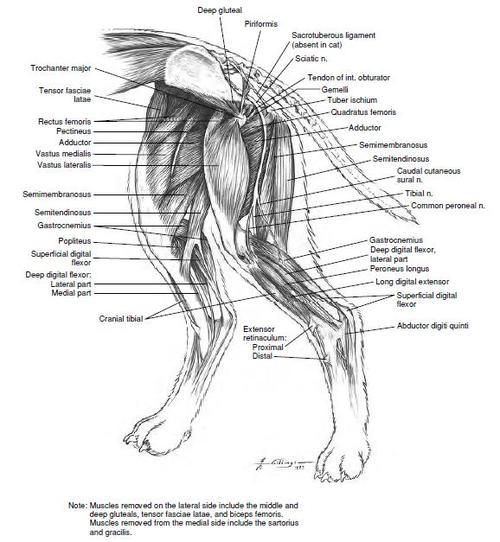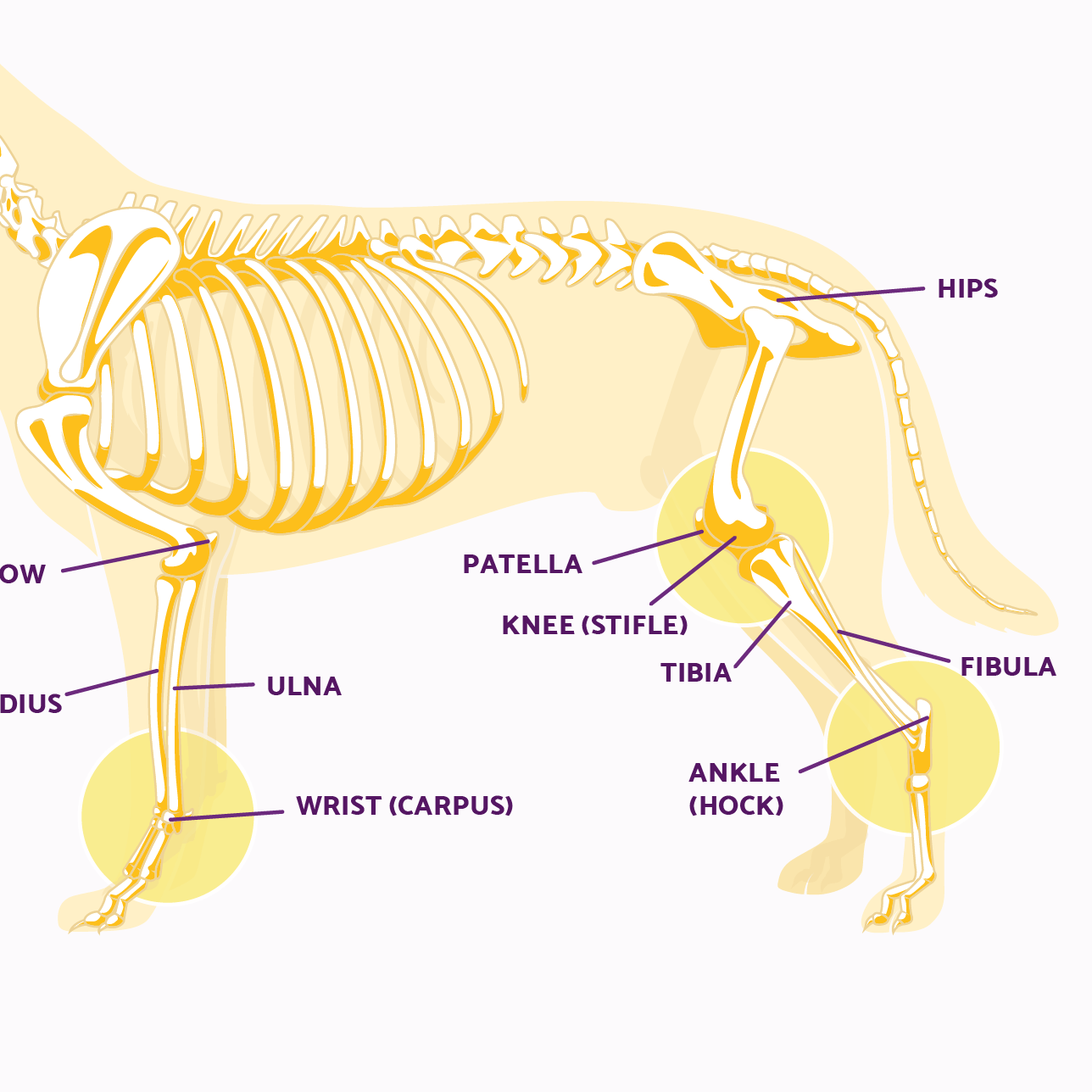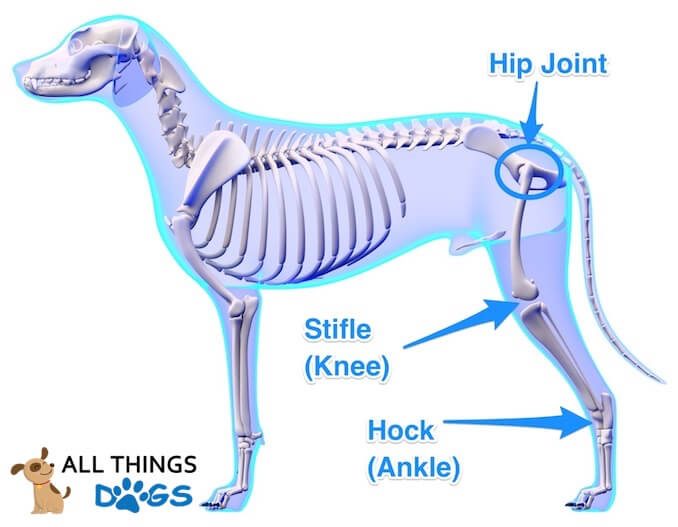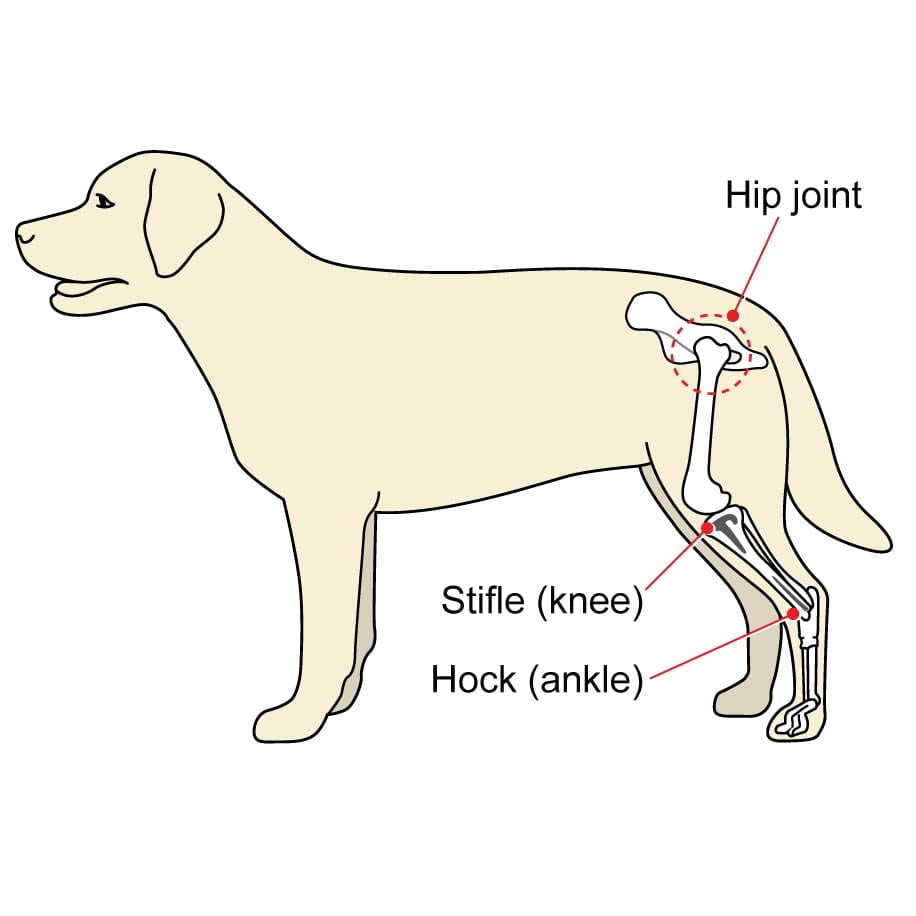
Dog anatomy front legs Canines Pinterest Dog anatomy, Anatomy
Dog anatomy lateral skeleton. The basics of the bones are: The femur: part of the dog's leg situated above the knee on the hind leg; The stifle or knee: the joint that sits on the front of the hind leg in line with the abdomen; Tibia and fibula: the part of the hind leg beneath the knee to the hock;

Best Guardian Dog Rottweiler's Anatomy Dog anatomy, Rottweiler, Dog leg
It provides information about a dog's skeletal, reproductive, internal, and external anatomy, along with accompanying labeled diagrams. After mating, dogs experience something called a copulatory tie, wherein they remain in the coital position. The male dog dismounts the female at this time. The dogs can remain in this position from a few.

Dog Leg Bones Diagram Canine Anatomy Veterian Key
You can find the most significant bones and muscles in a dog's rear legs. Dogs have knees, much like people, where the tibia and fibula meet the femur (where the lower leg meets with the thigh in dog hind leg anatomy). The stifle is the knee joint, while the hock, which functions similarly to an ankle, is at the back of the leg.

dogfrontlegboneanatomy Dog anatomy, Feline anatomy, Lion anatomy
The extensor digit I longus is a small muscle that directly lies on the tibia. This extensor muscle of the dog leg anatomy arises from the cranial border of the fibula bone between the proximal and middle third. The extensor digit I longus muscle extends obliquely deep to the long digital extensor, fibularis brevis, and finally, on the tibia bone.

Greyhound Anatomy Diagram The Inner Side of the Front Leg and the
Dog Knee and Knee Cap. Dog leg anatomy is complex, especially dog knees, which are found on the hind legs. The technical term for a dog knee is the stifle joint. The stifle joint connects the femur, which is the dog thigh bone, to the tibia and fibula, the lower leg bones, and the patella,the canine equivalent to the knee cap. Many dogs.

Dog Leg Bones Diagram Bone broth is a great way to add valuable
Understanding and knowing your dog's leg anatomy will help learn the possible weaknesses, injuries, and the best ways how to treat them. The dog is carried around by the forelegs and the hind legs. Much as the hind legs have got larger muscles that make them stronger, they only carry around one-third of their body weight. The forelegs or.

dog hind leg anatomy
Anatomy atlas of the canine general anatomy: fully labeled illustrations and diagrams of the dog (skeleton, bones, muscles, joints, viscera, respiratory system, cardiovascular system). Positional and directional terms, general terminology and anatomical orientation are also illustrated.

Dog Muscle Anatomy by TheDragonofDoom on DeviantArt
A dog's hip is made up of two bones: the . These two bones are joined by a joint called the coxofemoral joint. The femur, which is the longest bone in your dog's body, connects to this joint. The femur also connects to your dog's stifle (knee) joint, which makes up the hind leg. is located in the middle of your dog's pelvis, where it connects.

Dog Leg Anatomy in Human Speak Ortho Dog
Lameness is usually the first sign of a dog sprained leg — this indicates your dog is in pain. Swelling may follow. If the leg becomes warm or hot, however, it's unlikely that the limping is due to a simple sprain. If the sprain goes unaddressed, lameness may continue and, over time, leg muscles may weaken. When atrophy occurs in one limb.

Dog Leg Anatomy in Human Speak Ortho Dog
The major leg muscles in a dog play a crucial role in ensuring locomotion, stability, and flexibility. To understand their structure and function, it is essential to address the bones, joints, and ligaments that make up the dog's leg. In terms of bones, the dog's hindlimb mainly consists of the femur, the longest bone in a dog's body, which.

A Visual Guide to Dog Anatomy (Muscle, Organ & Skeletal Drawings) All
Dog rear leg anatomy. A dog's rear legs are where the largest bones and muscles are found. Just like humans, dogs actually have knees, and these are located where the tibia and fibula meet with the femur (where the lower leg meets with the thigh in dog back leg anatomy). The knee joint is known as the stifle, while at the rear back of the leg.

Dog Leg Anatomy in Human Speak Ortho Dog
Or you may read the below-mentioned article to get a basic idea of the dog leg muscles - Dog leg anatomy with a labeled diagram (with bone, muscles, and vessels), Tibialis cranialis and dog's hock. The most superficial and flattened muscle lies cranial to the tibia bone. This tibialis cranialis muscle arises from the cranial part of the.

What Part Of A Dogs Leg Is The Knee
The dog leg anatomy is a complex structure composed of various key components that work together to support the dog's movement and overall functionality. Understanding these key structures can give valuable insights into the dog's physical abilities and any potential issues they may face.

biomedicalephemera Medial and caudal views of the musculoskeletal
Most first-year veterinary students have a misconception of the term "leg." Anatomically, the term leg means the part of the hind limb that extends from the stiffle joint to the hock joint (knee to ankle or tibia and fibula bones region). This short post will try to cover thedog leg anatomyin detail.

canine muscular anatomy Dog Muscles Diagram
Dog Hind Leg Anatomy. The hind leg can be confusing to some owners, but it has some of the same features as a human. The bone between the hip and knee is the femur. Below the knee is the tibia and fibula. Then we get to the hock; you've probably heard this mentioned more in horses. The hock is like the human ankle.

22 best Animal Anatomy Canines images on Pinterest Animal anatomy
Dog skeleton. As with any vertebrate animal, the skeleton of a dog has the function of supporting the body for movement and protecting its internal organs. We can divide the canine skeleton into three main sections: Axial skeleton: skull, spine, ribs and sternum bones. Appendicular skeleton: bones of the extremities.